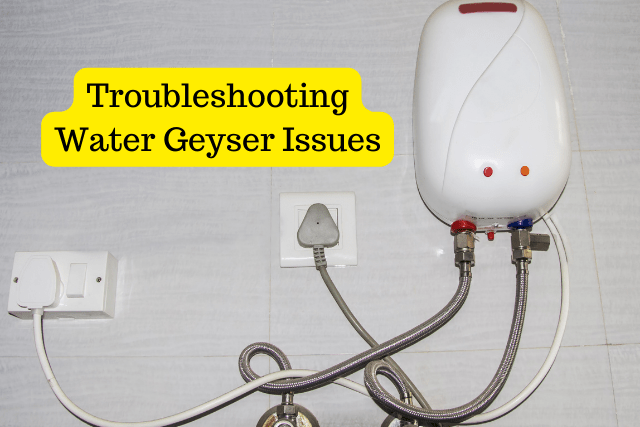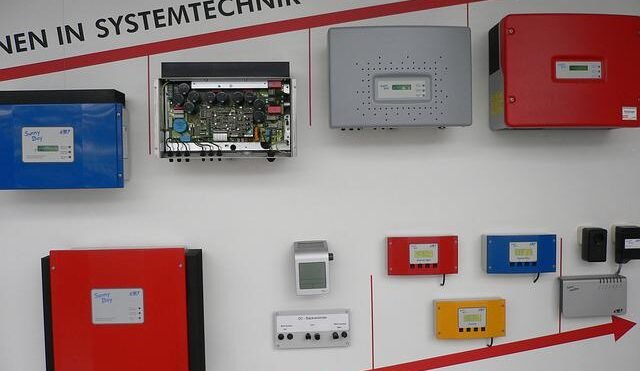Imagine a world without hot showers, spotless dishes emerging from steaming washers, or luxuriously warm baths to soothe away the stresses of the day.
This seemingly apocalyptic scenario would be our reality without the humble, hard-working water heater – that reliable household soldier toiling tirelessly to provide us with the simple pleasure of hot water on demand. However, even the mightiest of geysers can sometimes falter, leaving us high and dry (quite literally) when problems arise.
From rumbling tantrums and stubborn lack of hot water to leaks and energy-guzzling inefficiencies, our trusty water heaters can encounter a myriad of issues that require a deft hand and expert knowledge to resolve.
Fear not, for in this comprehensive guide, we’ll look into the most common geyser grievances and unveil the tried-and-true solutions that will have your water heater humming like a well-tuned soprano once again.
Prepare to become a hot water hero, armed with the insights to tackle any geyser glitch head-on and restore the soothing, cleansing flow that transforms your humble abode into a personal oasis of comfort and tranquillity.
Key Takeaways
- Temperature issues or unusual noises often indicate a need for repair, not immediate replacement.
- Frequent repairs or significant leaks, especially from the tank, suggest it’s time to replace the geyser.
- Minor fixes like adjusting the thermostat or cleaning sediment can efficiently extend a geyser’s lifespan.
- Evaluate the geyser’s age and efficiency; models older than 10-15 years may benefit from replacement for cost and energy savings.
Most Common Geyser Problems and Their Solutions
Here are some of the most common geyser (water heater) problems and their solutions:
No Hot Water
Nothing can dampen your spirits quite like the absence of hot water. In such cases, the first step is to ensure the geyser is receiving its lifeblood – electricity. Check the power supply and thermostat settings, and if all seems well, it may be time to flush the tank. Over time, sediment can accumulate, forming a stubborn layer that impedes the heating element’s ability to do its job effectively. If flushing fails to restore the flow of hot water, the culprit may be a faulty heating element in need of replacement.

Leaking Tank
A leaking tank is a geyser’s cry for help, and ignoring it can lead to costly consequences. Inspect the tank for cracks or corrosion, telltale signs that it may be time for a replacement. But before taking such drastic measures, examine the pipes and fittings for any leaks that could be resolved with a simple tightening or replacement. And don’t forget to ensure the temperature and pressure relief valve is functioning as it should, preventing potential disasters.
Rumbling or Popping Noises
When your water heater starts to sound like a disgruntled geyser, it’s a clear indication that something is amiss. These noises are often the result of sediment buildup, causing the heating element to struggle and strain. A thorough flushing of the tank may be all that’s needed to restore peace. If the noises persist, however, it may be time to replace the heating element, especially if it’s coated in a crusty layer of scale or sediment. In areas with hard water, installing a water softener can help prevent such issues from recurring.
Insufficient Hot Water Supply
There’s nothing more frustrating than running out of hot water mid-shower, leaving you shivering and reaching for a towel. In such cases, a simple adjustment of the thermostat’s temperature setting may be the solution. Alternatively, insulating the hot water pipes can help prevent heat loss, ensuring that the water remains toasty by the time it reaches your faucet or showerhead. If all else fails, it may be time to consider upgrading to a larger capacity geyser, one that can keep up with your household’s hot water demands.
Discolored or Smelly Water
Imagine turning on the tap and being greeted by a foul odour or discoloured water – not the most appealing scenario. This issue is often caused by sediment, debris, or a depleted anode rod within the tank. A thorough flushing can help clear out any unwanted particles, while replacing the anode rod may be necessary to prevent further corrosion and contamination. In some cases, installing a water filter can improve the overall quality of your water supply.
Energy Inefficiency
In today’s world, energy efficiency is not just a buzzword; it’s a necessity. An inefficient water heater can be a drain on your wallet and the environment. Insulating the tank and pipes can help reduce heat loss, ensuring that every ounce of energy is put to good use. But sometimes, upgrading to a more modern, energy-efficient model is the best solution, especially if your current geyser is nearing the end of its lifespan. And don’t forget to set the thermostat to an appropriate temperature, typically around 120°F (49°C), to strike the perfect balance between comfort and efficiency.
Pilot Light Issues (for Gas Geysers)
For those with gas-powered water heaters, pilot light issues can be a persistent thorn in your side. Ensure that the gas supply is functioning properly and that the pilot light is lit. If it stubbornly refuses to stay ignited, it may be time to clean the pilot light assembly or replace any faulty components. And remember, proper ventilation is crucial for the safe operation of a gas geyser, ensuring that any byproducts are vented safely away from your living spaces.
Regular maintenance is the key to prolonging the life of your water heater and avoiding costly repairs or replacements. Simple tasks like flushing the tank, checking the anode rod, and inspecting the components can go a long way in preventing many common geyser problems.
Identifying Common Issues
Common problems can make your water geyser not work right, including issues with the temperature, leaks, and noises. If the temperature goes up and down, it might be because of problems with the thermostat or heating element. A broken thermostat can’t keep the water temperature steady, making the water too hot or too cold. Also, if the heating element is damaged, it won’t heat the water properly.

Leaks in your geyser can come from different places, like connections that aren’t tight, rusty tanks, or pressure-relief valves that don’t work right. You might see water on the floor near the geyser or wet walls close to it. It’s important to fix these leaks quickly to stop water damage and avoid danger.
Noise problems, like popping, cracking, or hissing, mainly happen when there’s a buildup of sediment in the tank. This sediment is often minerals from the water that get left behind. They can make it hard for your geyser to heat the water well and might cause it to overheat.
Knowing these common issues can help you figure out what’s wrong with your water geyser and get it fixed or ask for help from a professional.
Assessing Repair Needs
When you find a problem with your geyser, you need to decide if you can fix it yourself or if you need to call an expert. Here are some tips to help you make that choice:
- Safety: If the issue is with electrical parts or gas, it’s best to contact a professional.
- Tools: Think about whether you have the right tools. Some fixes might need special equipment.
- Skills: Be honest about what you can do. Simple tasks like changing a thermostat might be okay, but harder problems might be too much for you.
- Warranty: If your geyser is still under warranty, trying to fix it yourself could cancel it.
- Time and Effort: Think about whether fixing it yourself is worth the time and effort, or if it’s better to hire someone.
Choosing whether to fix your geyser yourself involves thinking about these points. Making a smart choice helps keep your appliance safe and working well.
When Repairs Suffice
Before you decide to fix your geyser, make sure you can do it. Fixing common problems like a broken thermostat, a bad heating element, or small leaks can be easy and cheap. These parts are easy to get to and don’t cost much to replace, so fixing them is a good idea.
If your geyser isn’t making water hot enough, first check the thermostat settings. Sometimes, just changing the temperature or resetting the thermostat can fix the problem. If you’re not getting enough hot water, it might be because of sediment buildup. Cleaning out the tank to get rid of the sediment can make your geyser work better without having to replace it.
If there are leaks around the bottom of the tank, you might need to tighten some connections or change broken valves. But, make sure the leak isn’t coming from the tank itself, as that’s a different problem. Also, if your geyser’s pressure relief valve is letting out too much water or steam, changing it is an easy fix that can help your geyser last longer.
Indicators for Replacement
Knowing when you need to get a new geyser instead of fixing the old one is important. You don’t want to waste money on repairs that won’t last.
Here are the signs to watch for:
- Age: If your geyser is older than 10-15 years, it’s often cheaper to just get a new one.
- Frequent Repairs: If you find yourself calling for help more often than before, it might mean your geyser is nearly done for.
- Rising Energy Bills: An old or broken geyser can use more energy, making your bills go up. A new model could save you money in the long run.
- Leakage: A big leak, especially from the tank, usually means it’s better to replace the whole thing rather than try to fix it.
- Rust and Corrosion: If you see rust or corrosion, especially where the water goes in and out, it means the geyser is wearing out.

Making the Final Decision – Water Heater Tips
When thinking about replacing your geyser, it’s important to look at a few things carefully to make a good choice. Check how old and efficient your current geyser is. If it’s almost at the end of its life or if you find yourself fixing it a lot, which costs a lot of money, then buying a new one might save you money in the long run. New geysers use less energy, which means you pay less for electricity.
Then, see how big the problems are. Small issues, like a broken thermostat or a heating element that you can replace, might just need a fix. But big problems, like a leaking tank, mean you should get a new geyser. Keep in mind, that always fixing big problems can end up costing more than getting a new one.
Last, think about how this affects your everyday life. If your geyser doesn’t work well and makes you uncomfortable or inconvenienced, getting a new and reliable model can make your life better. Also, think about the warranty and service support that comes with new geysers, which can make you feel more at ease.
Frequently Asked Questions
Q: My water heater is not providing hot water at all. What could be the problem and how do I fix it?
A: There could be several reasons why your water heater is not working, such as a tripped circuit breaker, a faulty thermostat or heating element, or a lack of power supply to the geyser. First, check if the circuit breaker has tripped and reset it. If the issue persists, you may need to replace the thermostat or heating element or call a professional geyser service expert for further diagnosis and repair.
Q: I’m getting only lukewarm or cold water from my geyser. What could be causing this geyser problem?
A: The most common reason for getting lukewarm water is a malfunctioning thermostat or heating element within the water heater tank. Another possible cause is sediment buildup inside the tank, insulating the water from the heat source. You may need to flush the tank or replace the thermostat/heating element. Low water pressure can also contribute to inadequate hot water supply.
Q: I’ve noticed water leaking from my geyser. What should I do?
A: A leaking geyser is a serious issue that needs immediate attention. First, switch off the power supply to the heater and turn off the cold water supply to the geyser. Inspect the tank for cracks or corrosion, and check the water inlet and outlet pipes for leaks. If the leak is coming from the water heater tank itself, you may need to replace the entire unit. For leaks from pipes or valves, you might be able to get by with repairs or part replacements.
Q: What are some other common geyser problems and their solutions?
A: Other common issues include an overheating geyser (check the temperature and pressure release valve), water leaking through the ceiling (indicating a tank leak that needs replacement), low water pressure (caused by sediment buildup or faulty pressure valve), and discoloured or smelly water (flush the tank and replace the anode rod if needed). Regular water heater maintenance, like flushing and anode rod replacement, can help prevent many of these problems.
Conclusion
To figure out what’s wrong with your water geyser, look for common problems and decide if it needs fixing. If small repairs can make it work again, then just fix it. But, if your geyser often breaks down, works poorly, or seems unsafe, it might be time to get a new one. Think about how much repairs cost compared to getting a new geyser. Always choose what’s safest, works best, and will last the longest for your home’s hot water needs.







